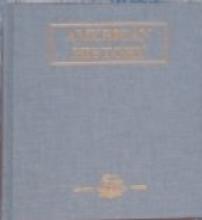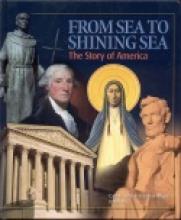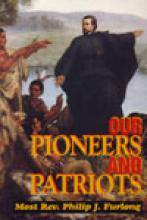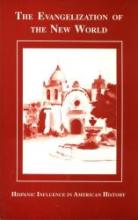United States History - Elementary Text
American History, Grade 5
Subject(s):
Setting:
Grade / Age level:
Resource Type:
Review:
There is no shortage of reprinted United States for elementary Catholic students, but this one designed for fifth grade offers a unique perspective. The student's text is an overview of American history from the discovery period through to 1963, with the final chapters on the history of machines and transportation and the Constitution.
The seven units and twenty-eight chapters are fairly brief at an average of ten pages, and the reading level is appropriate for fifth and sixth grade students. In the chapters are loads of black and white illustrations, maps and timelines. The end-of-chapter questions are all discussion and short answer or essay type, with a list of persons, places, and terms that might be useful for a timeline book assignment. In addition, there are some "Interesting Things to Do" that are more research and hands-on oriented. The end-of-unit questions are also discussion or essay type, critical thinking questions. Also included are a section called "Linking Geography to History", more "Interesting Things to Do", and a list of additional books to read. Many of the titles on the book list are familiar to me as they are what is presently being discarded from the library. Many of them are are out-of-print, but others are currently being reprinted in inexpensive paperback editions. If essay questions are more than your student is able to tackle, the corresponding test booklet includes tests in the typical multiple-choice and fill-in-the-blank format.
The Teacher's Manual contains the unique part of this course, and I would recommend its purchase as essential to getting the best out of this course. The reprinted edition is 95 pages long and is comb-bound. Its focus is on Christian social principles, which are outlined as an introduction to the Teacher's Manual and the course. Each unit has introductory information for the teacher, as well as an introduction to each chapter's material. These background notes are keyed to the list of Christian social principles and historical perspectives detailed in the introduction. Without this teacher's guide, I'm positive that I would have missed all of this. There is also a suggested test for the unit. For each chapter, the teacher's manual also includes a list of important terms and concepts, a useless-to-me list of related educational films and filmstrips, the answers to all of the student's questions, "Ideas to be Developed", and "Teaching Procedures". Because of the chronological arrangement of information, I think that the background information in the teacher's manual would be useful no matter which text you use.
Also available are a test booklet mentioned above and the answer key to the tests.
The seven units and twenty-eight chapters are fairly brief at an average of ten pages, and the reading level is appropriate for fifth and sixth grade students. In the chapters are loads of black and white illustrations, maps and timelines. The end-of-chapter questions are all discussion and short answer or essay type, with a list of persons, places, and terms that might be useful for a timeline book assignment. In addition, there are some "Interesting Things to Do" that are more research and hands-on oriented. The end-of-unit questions are also discussion or essay type, critical thinking questions. Also included are a section called "Linking Geography to History", more "Interesting Things to Do", and a list of additional books to read. Many of the titles on the book list are familiar to me as they are what is presently being discarded from the library. Many of them are are out-of-print, but others are currently being reprinted in inexpensive paperback editions. If essay questions are more than your student is able to tackle, the corresponding test booklet includes tests in the typical multiple-choice and fill-in-the-blank format.
The Teacher's Manual contains the unique part of this course, and I would recommend its purchase as essential to getting the best out of this course. The reprinted edition is 95 pages long and is comb-bound. Its focus is on Christian social principles, which are outlined as an introduction to the Teacher's Manual and the course. Each unit has introductory information for the teacher, as well as an introduction to each chapter's material. These background notes are keyed to the list of Christian social principles and historical perspectives detailed in the introduction. Without this teacher's guide, I'm positive that I would have missed all of this. There is also a suggested test for the unit. For each chapter, the teacher's manual also includes a list of important terms and concepts, a useless-to-me list of related educational films and filmstrips, the answers to all of the student's questions, "Ideas to be Developed", and "Teaching Procedures". Because of the chronological arrangement of information, I think that the background information in the teacher's manual would be useful no matter which text you use.
Also available are a test booklet mentioned above and the answer key to the tests.
Perspective:
Catholic
Additional notes:
Nihil Obstat and Imprimatur
Reviewed by:
First reviewed:
9-3-02
From Sea to Shining Sea
The Story of America
Number of pages:
462 pages
Copyright:
2003
Publisher:
Catholic Schools Textbook Project
Binding:
Sewn Hardcover
Subject(s):
Setting:
Grade / Age level:
Resource Type:
Review:
Perspective:
Catholic
Reviewed by:
First reviewed:
9/29/03
Our Pioneers and Patriots
Subject(s):
Setting:
Grade / Age level:
Resource Type:
Review:
Perspective:
Catholic
Reviewed by:
First reviewed:
1-3-05
The Evangelization of the New World
Subject(s):
Setting:
Grade / Age level:
Resource Type:
Review:
Perspective:
Catholic
Additional notes:
Though this title has been out of print for quite some time, it is readily available on the used book / resale market.
Reviewed by:
First reviewed:
1998-99




